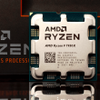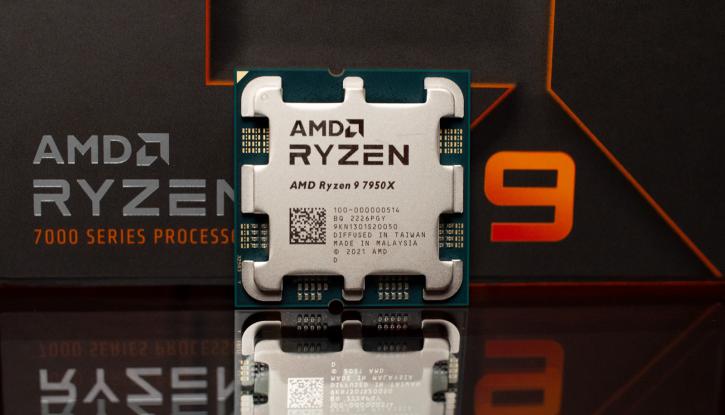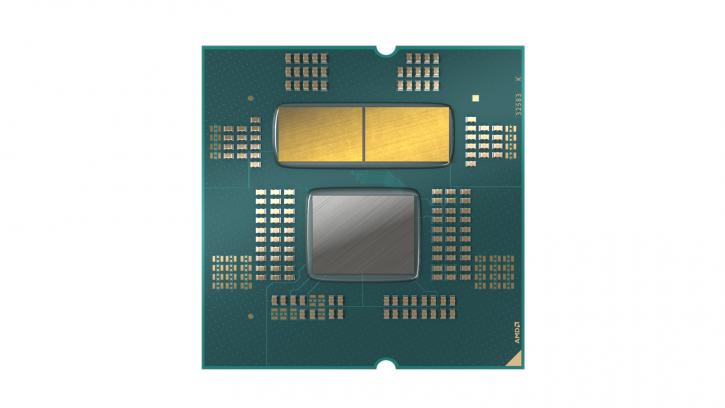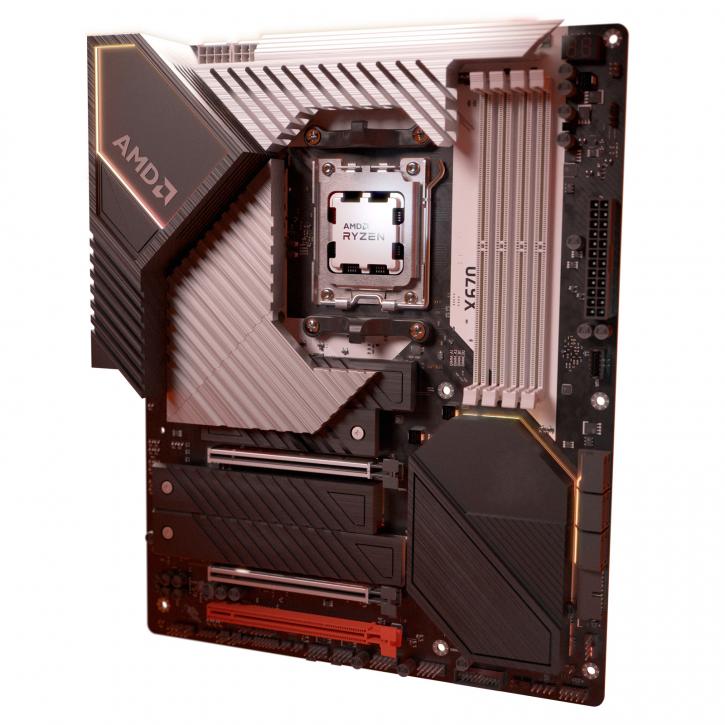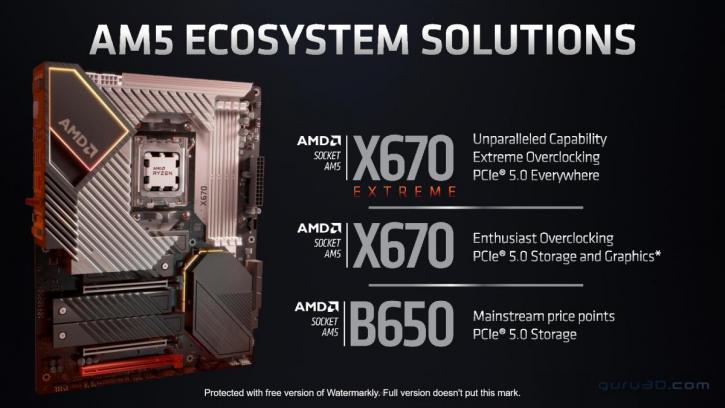Page 1
AMD Ryzen 7000 Series Processors announcement
AMD has announced its first ZEN4-based Ryzen 7000 processors. This article will recap what has been announced and what we can expect. The Summer of 2022 is nearly ending, and the year is well underway. While some updated graphics cards have been released this year, not much else has been newly released in the component hardware arena. However, the year will close with a bang, with new products from AMD, Intel, and NVIDIA. The rumor mill hasn't been silent, though; over the summer, nearly all specifications somehow leaked of the products they see launched today. Today is about the processor and motherboards. The new 5nm FinFET fabrication technique, the first in a desktop CPU, as well as enhanced performance combined with higher power efficiency, are among the primary highlights of the new processor generation. More information on AM5 motherboards for these models was also provided, as well as AMD EXPO, a new automatic RAM overclocking standard. The AMD Ryzen 7000 series is available late this month, unveiling four models on August 30th: the Ryzen 9 7950X and 7900X, the Ryzen 7 7700X, and the Ryzen 5 7600X. The base and boost clock speeds in particular, are greatly boosted in the four new CPU types compared to their predecessors.
The flagship Zen4 desktop CPU Ryzen 9 7950X will have 16 cores and 32 threads and is priced at USD 699. Meanwhile, the Ryzen 9 7900X with 12 cores and 24 threads with a boost speed of up to 5.6 GHz will cost USD 549. AMD has also confirmed the price of the 8-core Ryzen 7 7700X at USD 399 and the Ryzen 5 7600X at USD 299. On September 27th, all four CPUs will be available. AMD is only announcing these CPUs today. The Ryzen 7000 series will offer a 13% increase in IPC over its predecessors and up to a 29% increase in single-thread performance. This is mostly due to the higher clock speeds, which now reach 5.7 GHz on the flagship model, an 800 MHz increase over the existing series.
This is largely attributable to the upgraded Zen 4 architecture and smaller TSMC 5nm manufacturing process.
- Ryzen 9-7950X (16 cores/32 threads, 4.5/5.7GHz, 16MB L2 + 64MB L3, 170W TDP)
- Ryzen 9-7900X (12 cores/24 threads, 4.7/5.6GHz, 12MB L2 + 64MB L3, 170W TDP)
- Ryzen 7-7700X (8 cores/16 threads, 4.5/5.4GHz, 8MB L2 + 32MB L3, 105W TDP)
- Ryzen 5-7600X (6 cores/12 threads, 4.7/5.3GHz, 6MB L2 + 32MB L3, 105W TDP)
A first in a long time is a new processor socket, which allows for features like DDR5 and PCIe 5.0, and necessitates the purchase of new motherboards. The 600-series chipsets are built into these (X670E, X670, B650E, and B650). All the processors include an integrated RDNA2 GPU and PCIe 5.0 and DDR5 compatibility (E suffix is Extreme)
AMD Ryzen 7000 (codename Raphael) Desktop CPU Specs | |||||
|---|---|---|---|---|---|
| Cores / Threads | Base/Boost Clock | TDP | Cache (L2+L3) | Launch Price(USD) | |
|
AMD Ryzen 7000 Zen4 (Raphael) | |||||
| Ryzen 9 7950X | 16C/32T | 4.5/5.7 GHz | 170W | 80MB (16+64) | 699 USD |
| Ryzen 9 7900X | 12C/24T | 4.7/5.6 GHz | 170W | 76MB (12+64) | 549 USD |
| Ryzen 7 7800X? | - | - | - | - | 449 USD |
| Ryzen 7 7700X | 8C/16T | 4.5/5.4 GHz | 105W | 40MB (8+32) | 399 USD |
| Ryzen 5 7600X | 6C/12T | 4.7/5.3 GHz | 105W | 38MB (6+32) | 299 USD |
| AMD Ryzen 5000 Zen3 (Vermeer) | |||||
| Ryzen 9 5950X | 16C/32T | 3.4/4.9 GHz | 105W | 72MB (8+64) | 799 USD |
| Ryzen 9 5900X | 12C/24T | 3.7/4.8 GHz | 105W | 70MB (4+64) | 549 USD |
| Ryzen 7 5800X3D | 8C/16T | 3.4/4.5 GHz | 105W | 100MB (4+96) | 449 USD |
| Ryzen 7 5800X | 8C/16T | 3.8/4.7 GHz | 105W | 36MB (4+32) | 449 USD |
| Ryzen 7 5700X | 8C/16T | 3.4/4.6 GHz | 65W | 36MB (4+32) | 299 USD |
| Ryzen 5 5600X | 6C/12T | 3.7/4.6 GHz | 65W | 35MB (3+32) | 299 USD |
The ZEN4 CPU
Zen 4 CPU core-based products will power Ryzen 7000 desktop CPUs (codenamed "Raphael"), high-end mobile processors (codenamed "Dragon Range"), thin & light mobile processors (codenamed "Phoenix"), and Epyc 7004 server processors (codenamed "Genoa" and "Bergamo"). A lot has been said and spoken about ZEN4; AMD single and multi-threaded performance has been great overall, but with competition from Intel heating up, they have a new design with lots more cache and turbo frequencies moving to over 5.5 GHz. Overall, Intel was king in High turbo clock frequencies but a notch weaker in IPC. On the other hand, AMD has been very strong on IPC but less so in absolute peak clock frequencies.
That gave intel an advantage in many games with enthusiast performance graphics cards. In the past, a solution to bypass any performance degradation in gaming is to eliminate inter-core and inter-CCX latencies. Initially ZEN2 addressed that to some extent, with a few efficiency solutions found at cache levels. However, getting rid of the inter-core complex partition latencies is another thing. Zen 4 will continue to use an MCM (multi-chip module), or chiplet design; it will use up to two 8-core CCDs and one I/O die. There will only be one CCX per CCD, and this CCX will consist of eight cores. The Zen 4 core's key architectural advancements include higher data TLBs for the L1 and L2 caches and a doubling of the size of L2 cache per core, from 512KB to 1MB. A translation look-aside buffer (TLB) is a memory cache that stores the most recent virtual memory to physical memory translations. It is used to speed up access to a user memory location.
| Model | Cores/Threads | Base clock | Boost clock | Cache (L2+L3) | TDP |
| Ryzen 9 7950X | 16C/32T | 4.5GHz | 5.7GHz | 80MB (16+64) | 170W |
| Ryzen 9 7900X | 12C/24T | 4.7GHz | 5.6GHz | 76MB (12+64) | 170W |
| Ryzen 7 7700X | 8C/16T | 4.5GHz | 5.4GHz | 40MB (8+32) | 105W |
| Ryzen 5 7600X | 6C/12T | 4.7GHz | 5.3GHz | 38MB (6+32) | 105W |
So, factors like IPC, Clock frequency, and increased cache sizes will most likely result in performance improvements. In addition, AMD is bringing AVX512 instructions to Zen 4. As a result, applications that exploit this will obtain significantly bigger speed benefits.
Key changes from Zen 3
- AVX-512 instructions support
- L1 and L2 DTLB size increased from 64 to 72 and 2,048 to 3,072 entries
- L2 cache doubled from 512 KiB to 1 MiB per core
- Improved cache load, write and prefetch from/to register (less latency).
- Higher Transistor Density, due to 5nm process
- Capable of higher all-core clockspeeds (shown by AMD to reach 5GHz+ on all cores)
- An igpu in every processor
- PCIe Gen 5.0
- DDR5
There is a total of 64MB of L3 cache (ZEN3 32 MB and ZEN2 had 16MB per CCX ) shared across the cores in the CCX. There's also 1MB of L2 cache per core within the CCX, for 8MB of L2 cache per CCD. Similar to its predecessor, Zen 4 includes up to two Core Complex Dies (CCDs) manufactured using TSMC's 5nm technology and one I/O die manufactured with 6nm. Previously, the I/O die on Zen 3 was manufactured using GlobalFoundries' 14nm technology. For the first time in any Zen architecture, the I/O die of Zen 4 incorporates RDNA 2 graphics. Zen 4 is the first desktop CPU to utilize the 5nm manufacturing technology. On Zen 4, the L2 cache increased from 512KB to 1MB per core.
Integrated graphics
In the past AMD offers CPU and APU's, APUs are a processor with integrated graphics. AMD is seemingly changing this approach as all Raphael Zen4-based processors will be fitted with an RDNA2 graphics unit, which is good news. Those who don't play games or need a separate video card for some other reason needed to purchase a (hopefully) inexpensive card in addition to a standard Ryzen processor or even connect a monitor.This disadvantage grew much more severe due to the scarcity of graphics cards. Every Ryzen 7000 series CPU includes an integrated graphics processing unit, and that IGP resides in the I/O chip (6nm). Even though it is based on the contemporary RDNA2 architecture, it will likely have just two compute units. Therefore, it will not be suited for playing modern games.
Socket AM5
AM4 has been serving since 2016; AMD's Ryzen 7000 series has announced its retirement of the socket AM4 platform. This marks AMD's transition to PCI Express 5.0 and DDR5 memory. The AM5 LGA socket contains 1718 pins, which significantly increased over the AM4 socket, which had 1331. That increase is partly needed for DDR5, and 24 PCIe 5.0 lanes. Four lanes presumably just link to the chipset. After allocating 16 lanes to the graphics card, there will be 8 lanes left, four for direct-CPU-attached M.2 SSDs and four are used as interconnect. Remember, though, PCIe 5.0 video cards are not yet available. BTW your CPU cooler you can carry over towards the new platform as they will be compatible between AM4 and AM5 with the same mounting system
DDR5
The new platform will officially support DDR5. The controller is officially compatible with speeds up to DDR5-5200 (JEDEC default). However, AMD's Ryzen 7000 Zen 4 CPUs appear to have a sweet spot of DDR5-6000, allowing for a 1:1 IFC ratio (Infinity fabric Interconnect). A 1:1 ratio means that the memory runs at the same frequency as the memory controller on the CPU, which is the best-case scenario. With Alder, Intel has separated the memory ranks into two categories: a 2:1 mode known as Gear 2 that is the DDR5 default, and a 4:1 version known as Gear 4. A 1:1 ratio offers the advantage of allowing for lower latencies and faster speeds. A higher ratio, on the other hand, allows for better overclocking and faster data transfer rates but also results in higher latencies. DDR5-6000 for AMD Ryzen 7000 "Zen 4" CPUs already sounds amazing for AM5, with a default to DDR5-5600. Higher frequency DIMMs are supported; however, if you exceed the DDR5-6000 limit, you will be forced to use a 1:2 IFC. DDR5-6400 operating at 1:2 is said to offer poor results and is not advised if you want better gaming performance. AMD has been working on a new overclocking standard for DDR5 memory called EXPO, which the company intends to use as a competitor to Intel's XMP 3.0 protocol. AMD revealed earlier this year that it is working on Ryzen Accelerated Memory Profiles. EXPO will be the memory modules equivalent to Intel XMP 3.0, storing compatible ddr5 overclocking profiles with faster speeds and tighter frequencies. It is also advertised as a one-click memory overclocking solution.
Higher TDPs
Never had Intel had to fight this hard with a competitor, and for a good reason. In the performance/energy efficiency race, AMD has reached a level that can compete fully with intel. However, as it turns out, Raphael reveals increased energy levels. that goes for both companies btw; the flagship products from AMD will consume less energy, though. However, the TDP of the most powerful Ryzen 7000 models increases by more than 60 percent, from 105W to 170W for the PPT (highest amount of power that processors are permitted to utilize); for Intel, that looks to be 228W-250W (Core i9 13900K ). Therefore, the new top models' power consumption will be considerably lower than with Ryzen 5000.
X670E/X670, and B650E/B650 Motherboards
Chipsets will be formed of the X670E, X670, B650E and B650. AMD AM5 infrastructure is paired with that LGA 1718 socket and requires new chipsets. The 600-series platform comes equipped with DDR5 memory and PCI Express Generation 5 for storage and graphics. The platform supports 24 PCIe 5.0 lanes, 16 for the video card, four for an M.2 slot, and four more for connecting to the chipset.
The most opulent X670E chipset, where the E stands for 'Extreme,' can support two video card ports and an M.2 slot for an SSD with PCIe 5.0 bandwidth. Only the SSD on the B650 operates at PCIe 5.0 speeds. AMD has stated that the X670E chipset is designed for "unrivaled capability and extreme overclocking." It is designed to be able to supply PCI Express Gen 5 "everywhere." An X670 is designed for Enthusiast Overclocking and features support for Gen5 storage and optional graphics. Only the PCIe Gen5 storage standard will be supported by the mainstream platform based on the B650 chipset. The motherboard part of the 600 series will also include up to 14 SuperSpeed USB 20 Gbps (TypeC), and WiFI-E6 with DBS/Bluetooth Low Energy 5.2. Interestingly. Additionally, AMD has announced that the motherboards in the 600-series will come equipped with up to four HDMI 2.1 and DisplayPort 2 outputs.
Concluding
AMD is releasing Ryzen 7000 at a pivotal time in the industry, which has come to a halt throughout this year. Starting today, you'll see many products released with the heavily hurt PC component industry revive. With a bucketload of architectural changes, it, however remains to be seen if a 15% performance increase is enough. We say this so specifically because the platform bill of ownership is IMHO far to steep. 400 USD/EUR motherboard are becoming the norm, pricing for the CPUs have increased, and you need to purchase DDR5 memory. PCIe Gen 5 compatible graphics cards and NVMe SSD storage won't be cheap either. From a technology release point of view, things look much brighter.
The most significant technological advancement is AMD's migration from the now-outdated AM4 architecture to the AM5 platform, which includes support for DDR5 and PCIe 5.0. Zen 4 cores manufactured at 5nm are somewhat better, but most performance increases need higher clock frequencies, which regrettably come with increased power consumption. Furthermore, all Ryzen 7000 CPUs will now include an integrated graphics processing unit (iGPU), making AMD more appealing to customers who don't want to buy a separate graphics card. We hope that motherboard manufacturers will be able to get the platform backward-compatible with DDR4 as that can be a cost saver.
Availability
All four processors will launch late this month; AMD proclaims to have the proper volume of the product available at launch when reviews go live has yet to be announced. The 27th of September. Several models are priced the same as the previous generation, with the exception of the Ryzen 7 7950X, which costs $699, a $100 savings over the Ryzen 9 5950X.
